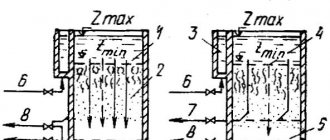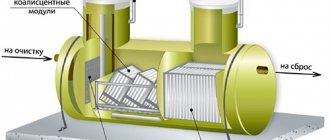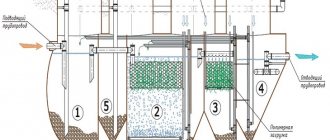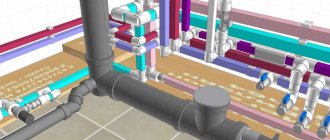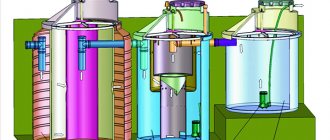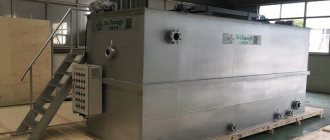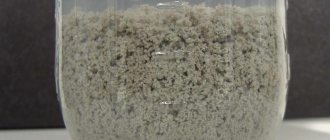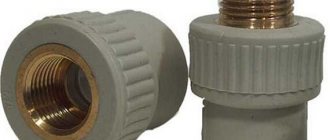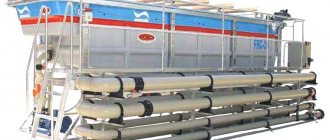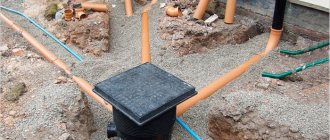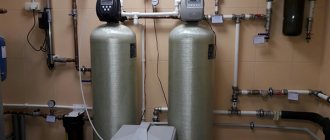Water, in the process of human use, changes its natural properties and very often becomes dangerous for consumption (from a sanitary point of view). That is why at all times, in human settlements, the organization of wastewater disposal was of great importance. This problem is still relevant today. Thanks to the achievements of modern technologies, at this stage, water disposal and treatment of municipal wastewater are organized at a fairly high level. Modern wastewater treatment systems efficiently perform the function of protecting the environment from human waste. But, unfortunately, in some small towns and villages there is no central sewerage system at all, and this situation is vaguely reminiscent of medieval Europe with its buckets of slop poured directly onto the streets. Therefore, the problem of wastewater treatment and disposal becomes private. Installation of autonomous sewage systems in country houses is now commonplace. Moreover, the difference between these systems and traditional cesspools is that they do not accumulate wastewater, but filter and purify it. There are three types of wastewater treatment that are used in autonomous sewage systems: mechanical, chemical and biological.
What is the negative impact of runoff on the ecosystem?
Household waste that people create in the course of their life causes great harm to the ecological system of our planet. Often, wastewater enters natural reservoirs , rivers and lakes, in an untreated form. When they get into wells, they contaminate the water, making it unfit for consumption.
In order to minimize the harm from wastewater, it is necessary to subject it to a settling procedure at special facilities. If wastewater treatment is not carried out effectively, the bacteria and chemical compounds they contain can cause irreparable harm to the environment. Plants and animals may also be affected.
Types of domestic wastewater
Domestic water contains colloids in soluble form and organic elements that do not dissolve. They are divided into:
- fecal;
- economic.
The concentration depends on the presence of clean water from the water supply network. Domestic water is formed after using water for household needs: after cooking, in baths, laundries, in hospitals, public and residential buildings, etc.
They contain physiological secretions of humans and animals, and household organic waste. Biological pollutants pose a danger to the human body. These are bacteria, fungi, parasite eggs. Inorganic components are salts of various substances. Their concentration in wastewater reaches 45-58%.
The water contains canned and non-canned substances. The former do not react and cannot be broken down into their constituent elements during the treatment of domestic wastewater.
The second type of pollutants is eliminated using biological treatment. Sand, slag, silt, and algae residues are physical pollutants. Biological – microorganisms and fungi.
Often wastewater is contaminated with chemical products: pesticides, heavy metals, compounds of chemical elements, etc.
Methods for treating household waste and industrial wastewater
Purification of such wastewater involves the implementation of a whole range of measures that make it possible to remove various substances and compounds from the contaminated liquid. At the moment, there are technologies that make it possible to disinfect even wastewater from petroleum products . In addition to them, there are treatment facilities that purify wastewater coming from livestock production facilities. Regardless of the technique used, it will belong to one of the main types:
- biological technology;
- mechanical technique. It involves the use of gratings, which are equipped not only with wastewater treatment plants, but also with stormwater treatment facilities;
- physico-chemical method;
- wastewater disinfection method.
To understand the features of each method and their effectiveness, below we will analyze in detail each method of wastewater treatment.
Mechanical method
This method is used by all treatment facilities that treat wastewater coming from commercial and domestic facilities. Before entering the fine processing departments, wastewater must be cleaned of mechanical particles . This method is used to rid wastewater of sediments that formed during other stages of wastewater treatment. The following elements can be used for this:
- devices that look like gratings or combs. Quite often they are equipped with mechanisms for self-cleaning. Often they are installed in sewer collectors;
- elements that ensure sand capture;
- membrane type filter elements;
- first order settling tanks;
- septic tanks.
A distance of no more than 16 mm should be maintained between the bars of the gratings. This requirement is due to the fact that they are used to filter out large elements. The waste obtained at this stage is subjected to a crushing procedure . Or it is possible to transport them to a place where they are further buried. After this, the water is purified using sand traps. Thanks to them, it is removed from the wastewater. The water also gets rid of small glass elements and other impurities.
Without crushing them, they are taken to warehouses for long-term storage. As further accumulation occurs, raw materials are used for various road works. I would like to draw your attention to the fact that the removal of contaminants in treatment facilities when using a mechanical deactivation method must be carried out regularly . If this is not done, the cleaning efficiency is sharply reduced. And devices, the task of which is to retain particles of contaminants, allow a large number of them to pass through.
Wastewater treatment using membranes is the most promising method. Its use allows achieving a high degree of waste deactivation.
When using a mechanical method for treatment facilities, no more than 70% of all impurities polluting wastewater . Therefore, in addition to them, other devices and technologies for wastewater treatment must be used.
Biological technique
Regardless of the type of wastewater, it is subjected to contamination with various types of bacteria. Using biological methods for wastewater treatment, it is possible to remove substances such as nitrogen and phosphorus, as well as anaerobic and aerobic bacteria from their composition.
Biological destruction technology is quite often used with this technique. Activated sludge can also be discharged into drains , and in addition, biological treatment filter elements can be used. How do wastewater treatment plants operate using this method of wastewater treatment?
First, the water enters the first-order settling tank. There, sedimentation of organic suspensions occurs. Small particles are subjected to the absorption procedure . The sludge accumulated in secondary settling tanks is removed using special pumping equipment. If desired, any suburban area can be equipped with such a system.
Currently, the market offers ready-made complex treatment facilities that can be used to treat liquid household waste using mechanical and biological methods.
The main advantage of such treatment complexes is that no major problems arise with them during operation. In addition, when using them, there is no need to perform frequent maintenance. After the water has undergone such purification, the unpleasant odor is eliminated . It can be used for various household needs, including watering pets.
Expensive models of wastewater treatment plants have a UV wastewater disinfection unit. By cleaning wastewater using such a station, you can then discharge water into natural reservoirs . In such systems, the efficiency of deactivation of household waste is at the level of industrial systems used in wastewater treatment plants.
Physico-chemical method
When this technology is used for treatment facilities, the following wastewater treatment methods are used:
- evaporation;
- performing wastewater treatment through ozonation;
- adding chlorine to wastewater.
These techniques are most in demand at enterprises that produce petroleum products, since they use more stringent techniques used to monitor the effectiveness of wastewater treatment procedures . Such drainage systems have recently become increasingly widespread among private homeowners.
They are installed in country houses for the treatment of domestic wastewater. You should know that you cannot use these techniques uncontrollably in your own area. The thing is that they require the use of chemical compounds in significant quantities. And they can harm not only human health, but also plants growing on the site, as well as pets.
Use of electrical impulses. This technology, when used, demonstrates the highest efficiency in cleaning household waste. There is only one drawback to the equipment that implements this cleaning method: cleaning wastewater in this way is quite expensive. Therefore, the purchase of such a cleaning system requires the owner to spend a lot of money.
Domestic wastewater treatment
Modern technologies that are used to remove contaminants from household wastewater are so advanced that water can be reused without fear. It is used for irrigation and technical needs.
Mechanical cleaning
Mechanical cleaning methods are used at the initial stage. It is used to extract coarsely dispersed residues in wastewater by settling and filtration. For these purposes, coarse filters are used in settling tanks. Using this method, up to 70% of contaminants are removed. The whole process is divided:
- settling;
- straining;
- filtration.
Mechanical methods are used in storm drains to prevent debris from entering the sewer system.
Settling tanks are used with and without heat treatment of the sludge. High temperature treatment is used to disinfect parasite eggs and infectious bacteria. The sediment is heated with steam to 115 degrees Celsius.
Treated sludge, related to mineral fertilizers, can increase plant productivity. Their introduction into the soil should ensure the absence of parasite eggs and pathogenic viruses.
Stages of domestic wastewater treatment
Biological treatment
Biological treatment is used to process domestic wastewater. Deep biological treatment plants process organic compounds using protozoa. They break down contaminants into gas and water using oxygen.
Bacteria need O2, so special conditions are created for them. Anaerobic bacteria process organic matter in sealed containers. This releases methane. Such installations require a ventilation system.
Disinfection of wastewater
Before sending purified liquid that has been used for economic purposes into a natural reservoir, it is necessary to carry out disinfection, and in addition to this, also decontaminate the wastewater. Recently, ultraviolet light has been increasingly used. However, these procedures can be performed using the classic method using chlorine.
You should know that treatment facilities should be located on the leeward side of a building or populated area . In addition, they should be placed on a site with a slight slope. This will ensure that wastewater is removed naturally without the need to install special pumping equipment. This is an extremely important point, especially when designing a city drainage system.
The protective treatment facilities should include the following equipment:
- a device that ensures uniform distribution of flows;
- devices by means of which excess polluting particles are removed from collecting devices automatically;
- equipment with which excess wastewater is discharged in an emergency;
- instruments used to measure the physical and chemical characteristics of wastewater, as well as their sediments;
- If necessary , installations that automatically take samples can be used.
Cleaning standards
Facilities and devices for wastewater clarification must provide the required level of purification - this is controlled by law. The most stringent rules govern the operation of sewage effluents coming from industrial facilities. The standards provide for the possible concentration of each substance separately in the clarified liquid.
For domestic wastewater, the requirements are not so severe. However, regulations still do not allow wastewater to be discharged into open water bodies or soil without treatment. Homeowners can be held liable for this.
There are no strict requirements for wastewater that is discharged into the ground after treatment. It is important for the homeowner himself that a relatively clean liquid gets into the soil. Otherwise, he can bring his territory to such a state that living in the house becomes impossible.
Ordering domestic wastewater treatment facilities
When you need reliable wastewater treatment facilities, it is advisable to prefer certified products from trusted manufacturers. Many modern entrepreneurs place orders at Technosphere Center. Prompt delivery is provided throughout Russia.
Each installation comes with a quality guarantee. Currently, the production of structures of this company is in enormous demand and respect in every corner of the Russian Federation. This is due to the fact that the high level of automation of each production process allows us to obtain products of impeccable execution.
Orders are always completed within the specified time frame. Moreover, this applies not only to standard products, but also to equipment made according to individual client drawings. The coherence and efficiency of actions of highly qualified employees will please the customer. Professional service and loyal prices are guaranteed.
Cleaning Requirements
Strict requirements for wastewater treatment exist only for the industrial sector. The standards indicate the permissible concentrations of all elements and substances. There are no strict standards for wastewater from sources of non-industrial origin. But the discharge of such liquids into open water bodies or soil is also prohibited. They must undergo the necessary procedures to remove the most dangerous components. For household wastewater that is discharged into water bodies, there are regulatory requirements for content and concentrations.
In modern conditions, the anthropogenic load on water bodies has seriously increased. A large number of toxicants enter wastewater not only from industrial enterprises; their quantitative indicators are also growing at the household level. Such unfavorable conditions require stricter measures to control the treatment of domestic wastewater. Today, the list of elements that are contained in limited quantities in wastewater entering treatment systems is more than 1,300 items. Great importance is attached to measures to remove nitrogen and phosphorus.
Sanitary and chemical indicators of wastewater treatment
The condition of treated wastewater is regulated by special sanitary rules and regulations. These documents provide a general list of maximum permissible concentrations and approximately safe exposure levels. Such lists include about 1 thousand items.
The control system is focused on maintaining a viable environment for fishery reservoirs, which includes the vast majority of natural rivers, lakes, ponds, etc. That is, discharged wastewater after treatment should not pose a threat to the fish living in the reservoir. The key indicator here is the oxygen concentration in the water.
Based on the requirements of regulatory documentation on the quality and composition of wastewater, all treatment facilities are designed. They allow you to plan the required number of methods for removing contaminants. On this basis, the size and number of treatment tanks are calculated, as well as a list of necessary equipment and devices.
